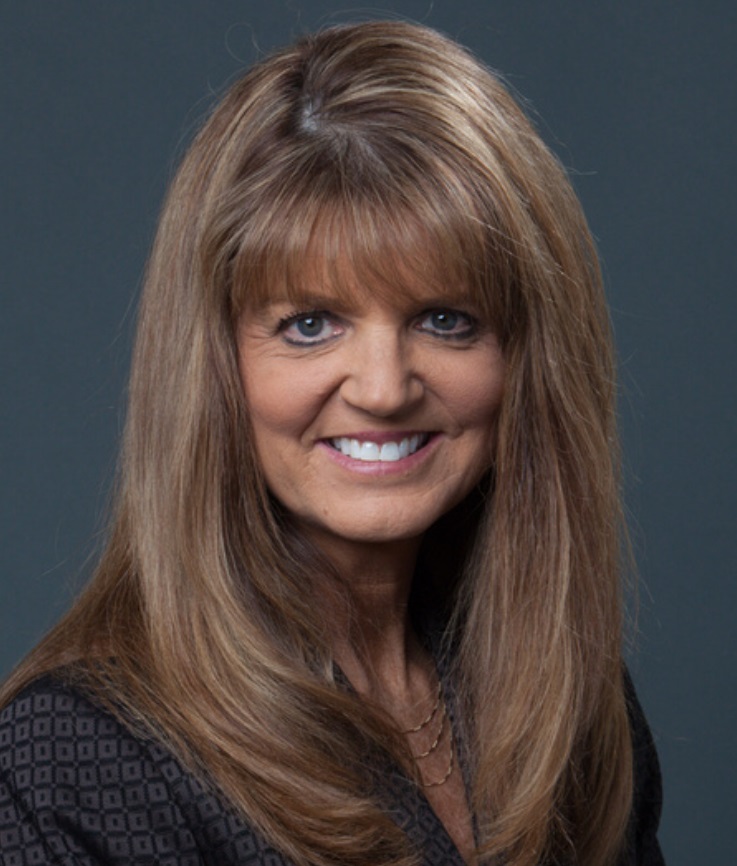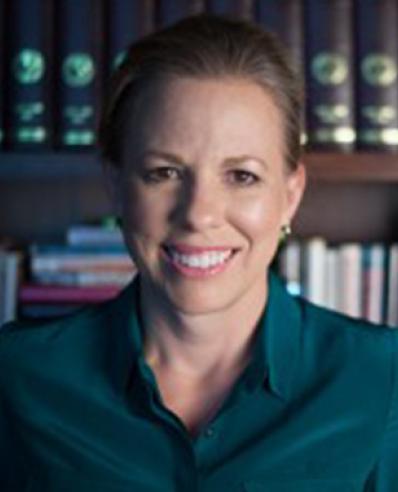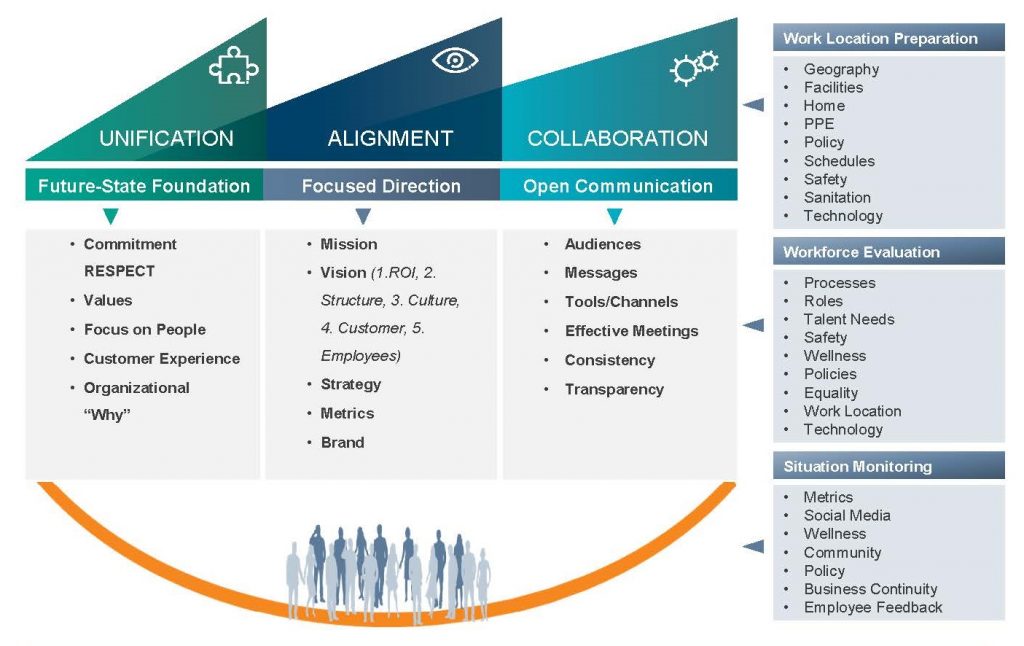The response to the pandemic from organizations can be classified into multiple phases. In the first phase, business leaders scrambled to equip teams for remote work. Later, ad hoc groups sprang up to devise return-to-office (RTO) plans. Soon after, many recognized they’d have to optimize tools and processes for remote collaboration that would last months longer than they had anticipated. And now, business leaders realize the new ways of working that have emerged during the pandemic may be the “new normal,” even after the world becomes safer.
As a result, forward-thinking leaders are engaging their employees to build a more adaptable, modern culture. They are enlisting teams to help design a new vision of a high-performance, integrated organization that is more agile and resilient. This effort begins with leaders articulating a vision for reemerging stronger and ensuring that newfound capabilities discovered during the crisis become intrinsic to the corporate culture.
A Vision for Reemergence
Reemerging from the crisis with higher-performing, better-integrated teams and a more resilient enterprise requires that leaders think beyond mere RTO strategies. Instead of attempting to restore pre-pandemic operations, leaders can start to guide their organizations to innovate and deliver more rapidly and successfully. The central idea is not to apply new abilities to reemergence alone, but to also make these skills and attitudes intrinsic to a collaborative and agile culture. If organizations retain their new agility and discipline as they reemerge, they can remain as adaptive as they’ve become during the pandemic.
Cultural Change
Building a culture of adaptability is essential. When an organization is flexible, it can adapt more easily to future market shifts, technological change and other eventualities that are sure to happen. Some of the key qualities of adaptability are agility, discipline and an attitude that welcomes change. These qualities of an adaptable culture are achieved through four practices behind every successfully change: unification, alignment, collaboration and innovation.
- Unification grows in organizations that value respect and focus on the welfare of their employees and customers.
- Alignment ensures that members of an organization share a common view of the enterprise’s mission, vision, strategies and brand.
- Collaboration embodies the principles that foster effective teamwork, such as consistency and transparency, as well as making habitual and effective use of collaborative technologies that have seen accelerated adoption during the COVID-19 pandemic.
- Finally, innovation is a culmination of these efforts, and can help to maximize the reemergence opportunity: Employees become contributors who are informed and aligned about corporate vision and initiatives, are empowered to think differently, and understand the strategies driving change.
A High-Performance Reemergence Model:
Executing the Reemergence Model
Enterprises can begin to execute a model for reemergence that embodies the attributes listed above. Leaders can start by clarifying the key stakeholders and collaborating on the development of a plan, including timing and responsibility for specific actions. In the case of preparing the workplace for reemergence, different teams can be designated to prepare work locations, evaluate workforce readiness and monitor the progress toward reemergence overall.
Here are some practical steps teams should consider:
- A work-location preparation team can be established to evaluate facilities for physical modifications like barriers and disinfection, as well as for policy changes necessary to ensure that employees are protected from contracting COVID-19.
- A workforce-evaluation team can assess the necessity of and alternatives to returning to the office. This effort involves defining the approach for a return of the workforce, including prioritization, rotation of staff and risk mitigation, as well as handling resistance to RTO and planning a response to incidents of infection. It may also include policy review and change, with a focus on telework, business hours, and technical and security requirements related to remote work, as well as on compliance with requirements and protocols for health monitoring, testing and contact tracing.
- A situation-monitoring team can be organized to develop metrics and monitor events to determine the organization’s readiness to progress with reemergence – or its need to reverse course. This team can also be tasked with defining an approach for enforcing new policies, establishing roles and responsibilities, and reporting specific COVID-19-related reemergence activity.
- The human resources, information technology and finance teams can supply the expertise and perspectives of their particular functions.
Together, the teams will collaborate with leaders and stakeholders to implement an adaptable reemergence model as follows:
- Gather information concerning the current state and new requirements throughout the organization.
- Create reentry protocols, or a playbook, to identify the reemergence activities/timelines needed along with policies, workplans and metrics.
- Identify communication needs and work with leaders to develop a communication plan. This activity includes communicating changes to the reentry playbook to all affected parties, and planning approaches, responsibilities, and timing to reach, enlist and educate stakeholders.
- Update the reentry playbook with refinements to policies, procedures, communications and supporting materials as the work progresses.
Governance – Change Leaders
Operational leaders have an essential role to play in the reemergence plan. In addition to monitoring the changes underway and reporting on progress to executive leadership, they must be prepared to build new capabilities into the organization. These leaders can introduce new ways of learning and working for the organization, including the following:
- Work-location leads, representing every facility and office, can develop workplace modifications and policy alternatives to enhance the safety of employees.
- Workforce leads can evaluate which roles can be performed on-site and which can be executed remotely. They should identify ways to maximize the productivity of each role and determine the approach for bringing specific functional roles back to the office.
Conclusion
There is no one-size-fits-all reemergence plan. We have observed some organizations form change-governance councils to drive and oversee the reemergence strategy. These councils often include representatives across the organization. Regardless of the structure, one common factor among these strategies is that they prioritize the wellbeing of employees and teams. Executive involvement is also essential to the success of all reemergence efforts. Leaders should model the new behaviors, new policies and practices they want to implement and act quickly to remove old practices and processes that are often obstacles to progress.
Just as the onset of the pandemic left no life unchanged, reemergence into a new world of work touches everyone. The volume of new information, practices, protocols and technologies that need to be reevaluated and potentially changed means proactive, clear communication is essential to ensuring all employees, leaders and stakeholders remain engaged and informed.







